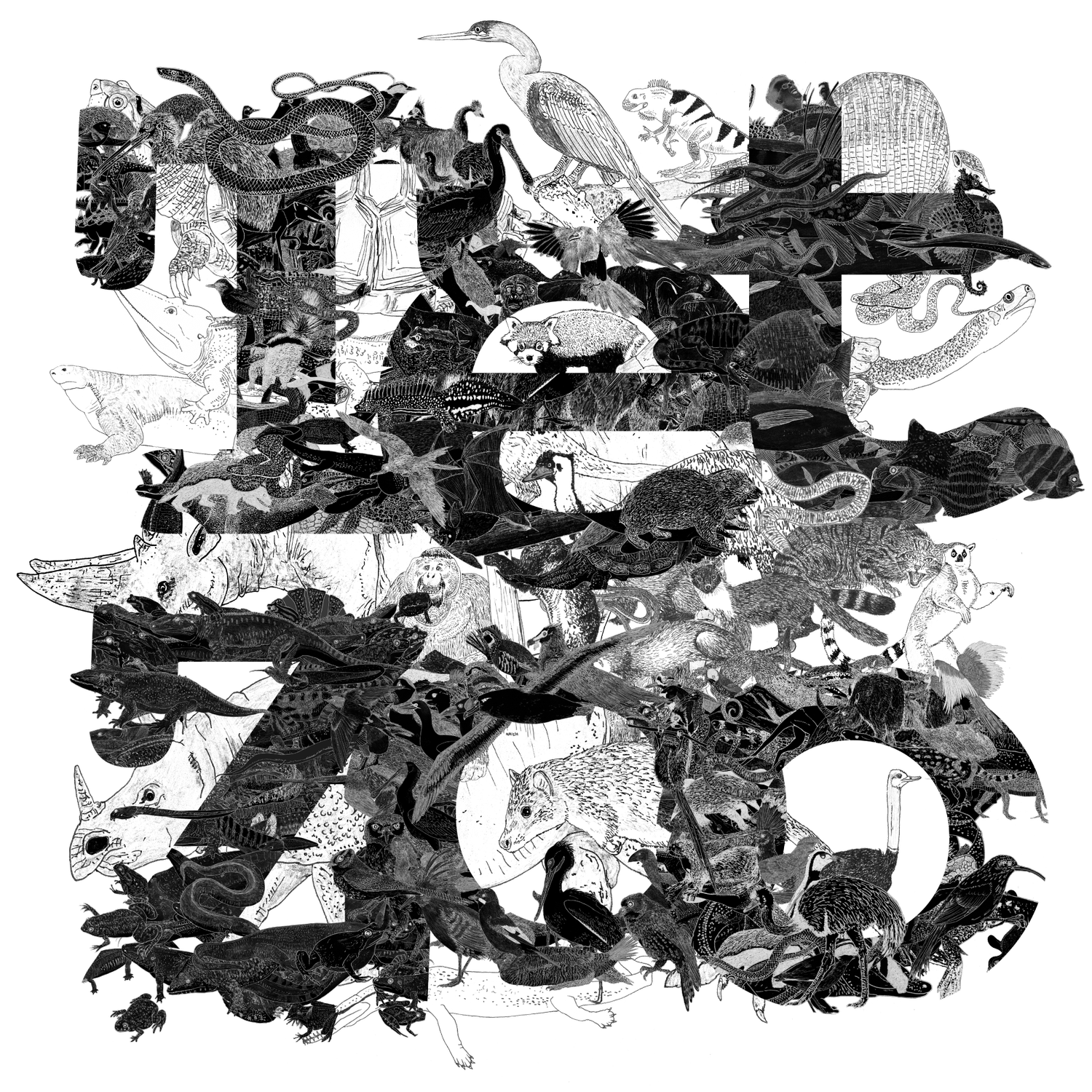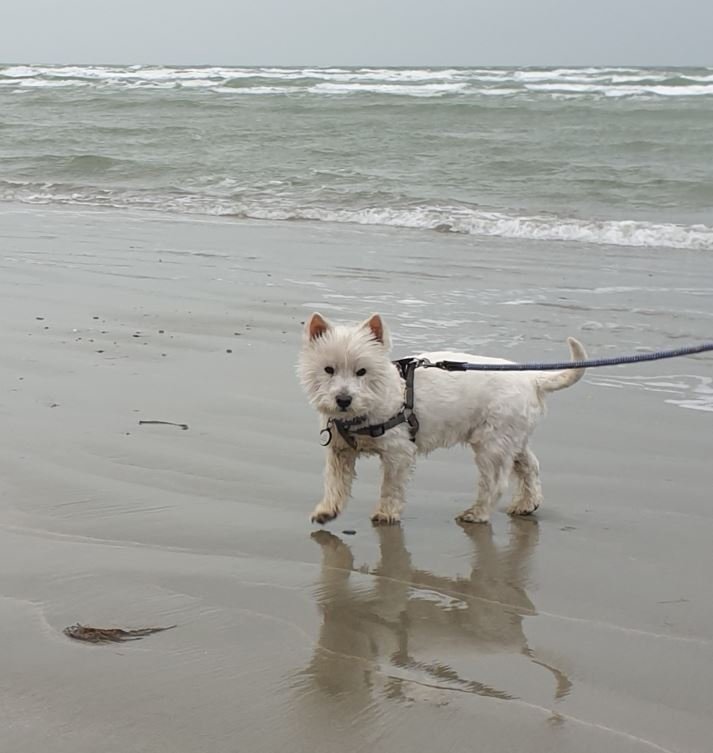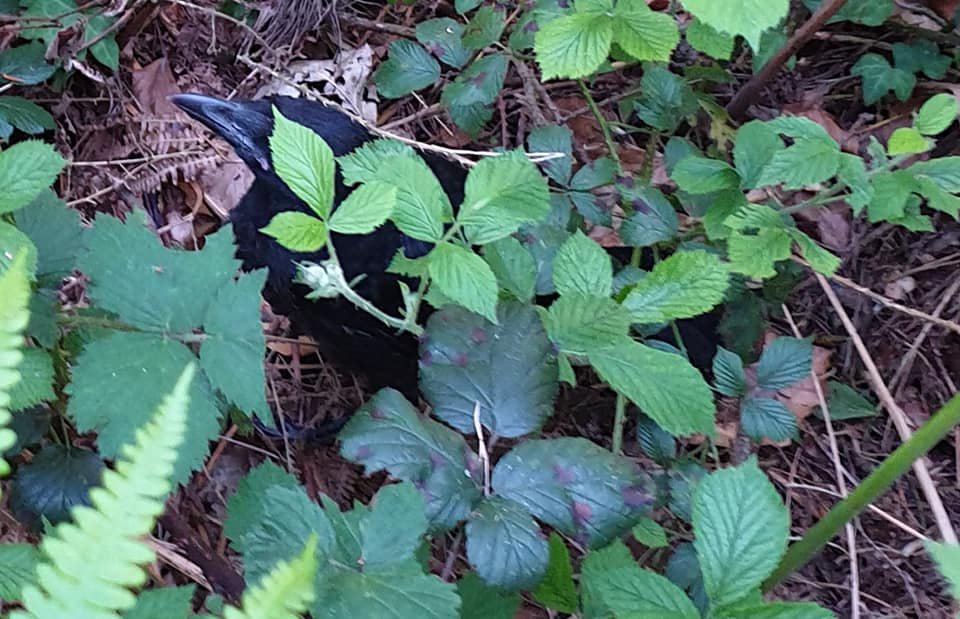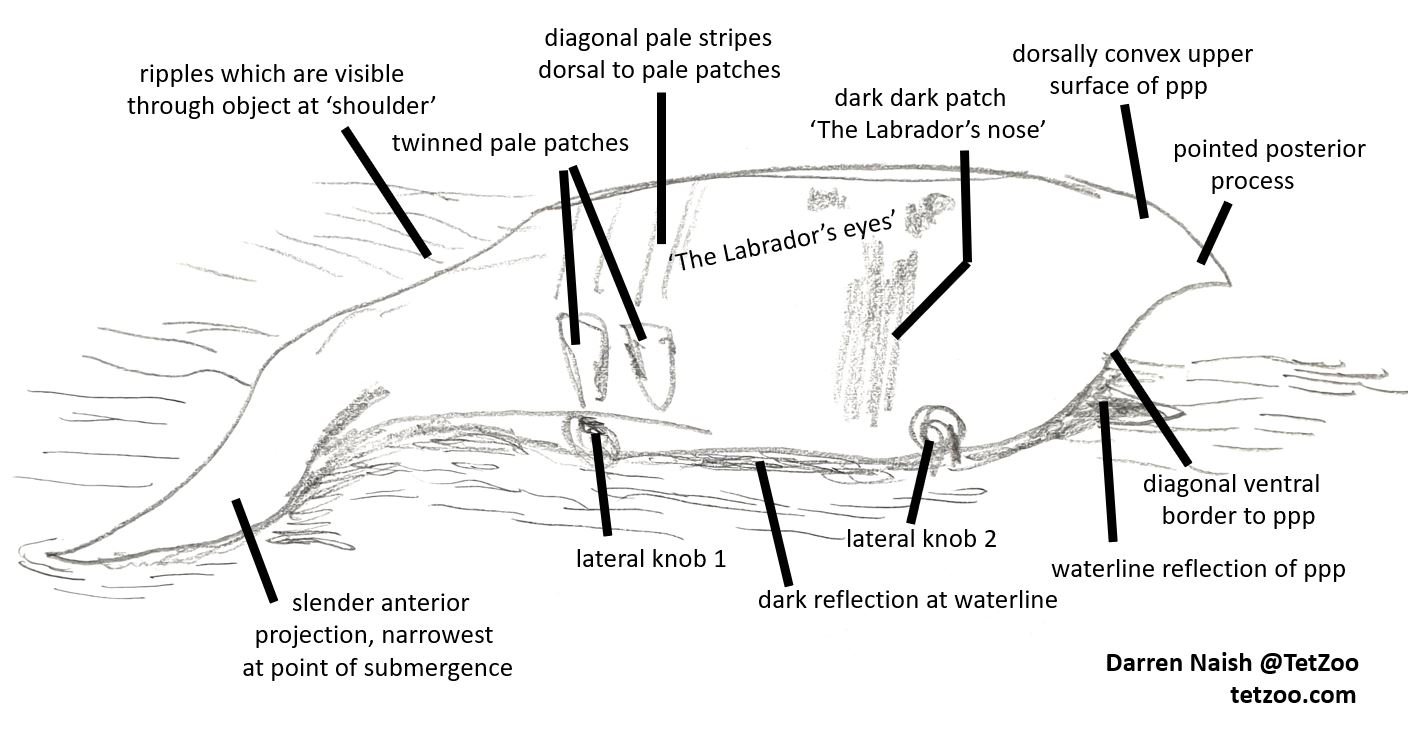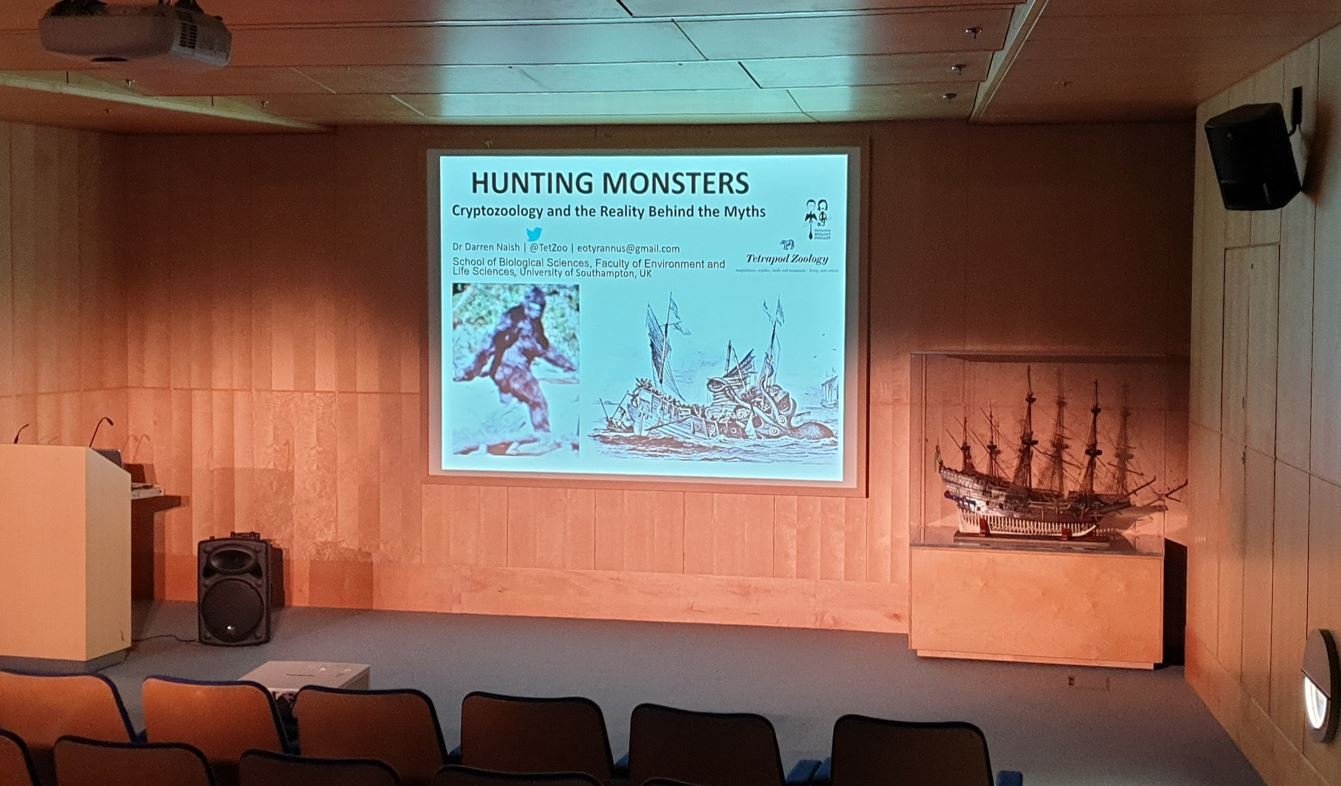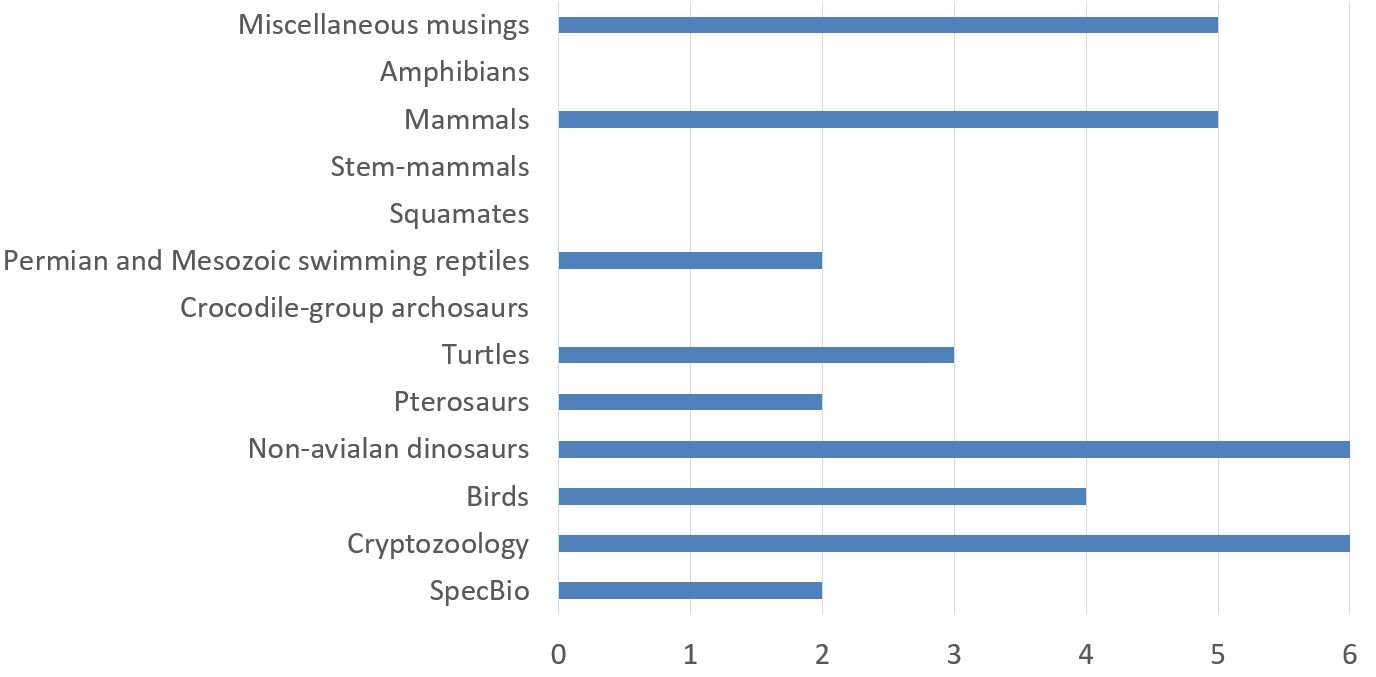What happened at Tet Zoo Towers during 2021? Well….
Caption: Teddy the West Highland terrier on the wet beach at West Wittering. Could this be a metaphor for the adventures of 2021; Teddy’s incomplete reflection being a reference to our own incomplete fulfilment of life during the year; the cold, wet conditions reflecting the hostility of modern discourse? No; it’s a photo of a small white dog. Image: Darren Naish.
On January 21st 2022, the Tetrapod Zoology blog turned 16 years old. There was no party, no celebration. But perhaps there should have been. In the following article I look back, as is tradition, at the previous year’s events as seen from here at Tet Zoo Towers. As is typical for these birthday articles (which I’ve been doing for as long as the blog has existed), the following article is sickening in its degree of introspection and self-congratulation, and I advise you to stop reading now if continuing any further sounds like a regrettable endeavour.
Caption: our bearded dragon Flame enjoyed time in the garden during 2021. This is what happens when (during hot weather) I put her down near the pond: she wades into the water and drinks. Image: Darren Naish.
Final warning.
2021 was, as you’ll know, another unusual year when ‘normal’ things just didn’t happen. I mostly worked from home for the entire year and hardly travelled. But in spite of this – or perhaps because of it – 2021 was a significant year in terms of personal achievements: I got a fair number of important things finished and even published. Other things edged closer to completion. Others remained on the backburner and no closer to completion.
Caption: two papers I - with colleagues - succeeded in publishing in 2021; the Naish et al. (2021) pterosaur hatchling study, and the Barker et al. (2021) baryonychine description. Images: pterosaur image at left by (c) Mark Witton; baryonychine skeletal reconstructions by Daniel Folkes.
Foxes, badgers, frogs and a display cabinet. In order to get out of the house and engage in at least some exercise, I took to embarking on long walks during the cold January nights. There isn’t much green space in proximity to where I live, but there’s a bit of it within a half-hour’s walk. I began to have regular close encounters with the several Red foxes Vulpes vulpes that live in the area. I then discovered – entirely fortuitously – that badgers Meles meles live in one of the areas I was visiting too, and after repeated nocturnal visits to the same location I managed to get a few awful, low-quality photos. The fact that the badgers concerned would rush across a road to get back to the safety of the woods once aware of being watched gave me concern that my presence was putting them in danger, so I only indulged in this for the briefest time. When I ‘discovered’ these badgers I only ever saw two. My fear is that they’re the last survivors of their group, the last vestiges of a shrinking population surrounded by suburbia, doomed to extinction. I hope I’m wrong
Caption: all of my night-time photos of foxes and badgers are…. terrible! But I like to think they have a sort of aesthetic charm all their own. Image: Darren Naish.
For years now I’ve been intending to someday obtain a new display cabinet for my sizeable collection of animal figures, and I’m pleased to say that this happened late in January. Getting it into the Tet Zoo Towers office was one hell of an ordeal and once in place the cabinet was filled to the brim almost immediately. I need more cabinets if I want the rest of the collection on display but that’s not gonna happen given the size of our house.
Caption: part of the top shelf of cabinet 2. New acquisitions for 2021 include the Minnesota iceman at far left (a gift from Loren Coleman). Image; Darren Naish.
Caption: somehow, new animal figures mysteriously found themselves in my collection in 2021. Several of those shown here were birthday gifts. Image: Darren Naish.
Those who follow me on social media might know that I’ve been following and charting the changing fortunes of the frogs that frequent the Tet Zoo Towers ponds. This being the UK, the frogs here belong to the only species that’s widely distributed across the country: Rana temporaria, the Common frog. Since I’ve constructed our two ponds, the breeding frog population has increased steadily year on year. In 2021, 13 were present by the end of January, which is tremendous given that there only appeared to be one or two when we first moved into the area in the early 2000s. What might the count be for 2022? I will come back to this in time…
Caption: Common frogs (and their spawn) in pond 2 during February 2021. A great year!
TetZoo saw articles on Morgawr (the alleged Cornish sea monster), my review of Johnson’s The Feather Thief and tortoises as carrion-eaters during the January, February and March of 2021. I also published megathreads on the Migo film of 1994 (this was also converted into a TetZoo article) and Kevin Cameron’s thylacine photos of 1984. My thylacine writings were inspired by the then-newsworthy claims of Mr Neil Waters and the Thylacine Awareness Group that live thylacines (both adults and a juvenile) had been photographed in Tasmania. I was interviewed about this case by Asher Elbein who folded my words into the article published here. I also recycled my words for a TetZoo article on putative thylacine survival, and John Conway and I discussed thylacine survival in episode 81 of the TetZoo podcast in March as well. We were clearly on a roll, as we released episode 82 in April.
Caption: the journey has been arduous. Has it all been worth it? I have no idea but at least there are books.
On science writing. February 2021 also saw the publication of my ‘Becoming a science writer’ (Naish 2021a) in Biological Sciences Review. I’m certainly no expert on how to break into science writing but can, of course, relay my own experiences as if they might be useful. I make no secret of the fact that I simply haven’t found science writing a ‘functional’ career (as in, I’ve never earnt enough money from it to ensure financial stability and security), have mostly made bad decisions throughout my professional life, and have never found writing or creating at all easy in view of other pressures (like: necessary other jobs that burn up time, and life with a family). This is a somewhat negative, off-putting view that I don’t think people expect to see, but I can’t pretend it isn’t front and centre in my mind whenever I discuss the topic. It meant that some people saw my submitted text as unduly pessimistic, but there it is.
On a similar note, it takes me very literally years to complete scientific papers and to then jump through the numerous hoops reviewers, editors and journal staff require before any project is finished. I managed to complete and submit one such paper – that describing the flight behaviour and inferred biology of hatchling pterosaurs, co-authored with Mark Witton and Liz Martin-Silverstone – in mid-March. And it was then immediately sent back to me. So I made the required changes and submitted it again at the end of March. Aaaaaaand it was then immediately sent back to me, at which point I had to give up and shelve it again.
Godzilla vs Kong, Gaia and Starlux toys. Efforts to travel locally and see as much wildlife as possible continued, and I (with family) made trips to the nearby Itchen navigation, Westwood, the New Forest, Victoria Country Park and Lepe Country Park. The movie Godzilla vs Kong premiered in May 2021. As a scientist and author who sometimes writes about monsters, it isn’t surprising that I was asked to write about the events of the film. My piece for BBC Science Focus Magazine is here (but appeared in April rather than May). Having mentioned Godzilla, I should also mention that I received honorary mention in a Godzilla parody video during March. What an honour.
Caption: a scene from Vrahno’s very impressive Godzilla Gets a YouTube Award, Part 1 (Fan Parody Animation).
I went to Marwell (my local zoo: I go there a lot), and enjoyed especially good views of binturong, anoa and snow leopard. May was also the month in which I finally finished work on Dinopedia, something only possible due to my going without sleep for a time. My method of working is absolutely unsustainable and I’m taking years off my life. I have to mention in passing that some behind-the-scenes happenings related to Dinosaurs In The Wild happened in May too, though I can’t yet say what they are. And if you don’t know what Dinosaurs In The Wild is, check out the TetZoo article here. I gave a brief presentation on the history of Starlux toys at PopPalaeo during late May: I really should write it up and publish it.
Caption: the Starlux Spinosaurus. I’m pretty confident that this is the oldest Spinosaurus figure in existence. If you know palaeoart history, it’s very clearly based on a late 1970s painting by Giovanni Caselli. Image: Darren Naish.
The second article on carrion consumption in tortoises was published at TetZoo as were my two articles (part 1, part 2) on my reminiscences about the BBC TV series Walking With Dinosaurs. I visited ZSL Whipsnade Zoo (hence the article here) as well as Greenwich Naval College in order to see Luke Jerram’s travelling Gaia installation. It’s a 7-m-wide illuminated scale model of the Earth intended to create the ‘overview effect’: a connected set of warm feelings for our planet and those who dwell on it.
Caption: one of my favoured local patches, Telegraph Woods. Like so many of our wooded areas, it’s mostly young, mostly lacks big old trees and is mostly over-used by people and their dogs and nowhere near as wild as it should be. But it’s still extremely valuable local habitat and I love spending time there. Image: Darren Naish.
Megathreads published at about this time included those on Slavomir Rawicz’s supposed 1941 yeti encounter and the U28 sea monster observation of 1914. On the subject of cryptozoology, I also spoke to Rick Minter for his Big Cat Conversations podcast. Our discussion mostly revolved around Mark Hallett and John Harris’s book On the Prowl: In Search of Big Cat Origins but we used it as a springboard to discuss the evolutionary history of cats big and small across Europe and indulge in some speculative thoughts on British big cats (should they exist). The episode went live in early July and can be listened to here. I also participated in a LiveScience discussion devoted to feathered dinosaurs during early July too (it’s on youtube here). By this time of the year, I’d started to make progress on my Ancient Sea Reptiles book. I did eventually get it finished, but not in time to meet the deadline.
Caption: Eurasian moorhen Gallinula chloropus adult and chick, photographed in June 2021. Part of a Black-headed gull Chroicocephalus ridibundus is in shot as well; the gulls kept a respectful distance from the moorhen, as rallids are badasses. Images: Darren Naish.
I took a week off work during July specifically to get the figures of the Eotyrannus monograph finished. Despite working on them as much as I could, a week just wasn’t enough time and the job was left incomplete, much to my frustration. I kept plugging away at it, though, and did succeed in re-submitting it in August. Only for it to be immediately sent back due to a list of issues.
Caption: while walking through the woods in May 2021, I glimpsed a flash of dark movement at the base of the tree. It was an adult Carrion crow Corvus corone, encouraging its chick – which you can see here – to get off the ground and back into the trees. I only realised this on close approach; I quickly took this photo and retreated quietly. Image: Darren Naish.
Baby pterosaurs and dinosauroids. The month did, however, see final publication, in Scientific Reports, of the baby pterosaurs paper mentioned above (Naish et al. 2021). Getting this out there marks the end of a several-years slog, and it got to the stage (as so many papers do) where I and my co-authors (Mark and Liz) simply wanted it out of the way. If 2021 were a normal year, we would have met up for drinks on the occasion of its publication… but 2021 wasn’t a normal year, was it. My thoughts on the paper and what it means are here; it was Technical Publication Number 1 for 2021.
I went to Amazon World on the Isle of Wight, a small collection that has some great animals… even if they don’t have the Harpy eagle that the entrance implies.
Caption: assorted animals of Amazon World (technically, Amazon World Zoo Park), Sandown, Isle of Wight… male White-face saki Pithecia pithecia, Greater flamingo Phoenicopterus roseus, non-existent Harpy eagle Harpia harpyja. Images: Darren Naish.
My paper on the backstory to Dale Russell’s dinosauroid – co-authored with Will Tattersdill – appeared in print in late August (Naish & Tattersdill 2021), and of course I’ve already written about it at length (the TetZoo article is here). It’s an unusual paper for sure but it still counts as a technical, peer-reviewed study, so getting it published was a big deal and it counts as Technical Publication Number 2 for 2021. I spoke about the dinosauroid at one of Chris Manias’s PopPalaeo events (held via zoom, of course) and at TetZooMCon later in the year too.
August 2021 was also the month in which the Natural History Museum’s Dr Angela Milner passed away, and it only seemed appropriate to write about her and her work here at TetZoo. The article concerned is here.
Caption: the Hugh Gray Loch Ness Monster photo of 1933 – the first Nessie photo – possesses a set of anatomical details that (I argue) are linked to its probable true identity. Image: Darren Naish.
I also published another instalment in the TetZoocryptomegathreads series, this time on the Hugh Gray Loch Ness Monster photo of 1933. I see what I think is good evidence that the photo shows a Whooper swan Cygnus cygnus, exposed in several different poses in the same image. I’ve experienced a tiny amount of pushback on this, the objections mostly focusing on the skittishness of wild Whooper swans and on their rarity on Scottish lakes during the 1930s. Those are certainly interesting asides or tangents to the story but they’re certainly not ‘obstacles’ to the main thesis, since an acknowledged part of the problem with Hugh Gray’s photo is that we don’t really know when or where it was taken, nor is there any proof that it was taken at Loch Ness. Indeed, this ambiguity is consistent with the idea that the photo is a hoax and that Gray was not an honest actor.
Caption: your reminder that many people who claim weird experiences already inhabit their own world of weirdness. They are very often not neutral or impartial experiencers. I put it that Hugh Gray, famed Nessie photographer, was one such person. Image: Darren Naish.
The 2021 Fortean Film Festival and British big cats again. Over the course of 2021 I worked (here and there) as one of the judges for the Fortean Film Festival, viewing submitted films before reviewing and rating them. Things came to a head at the end of August as those of us involved gathered at the Sherborne Cinema (a small, ‘vintage’ cinema) in Gloucester. The event wasn’t perfect – they really should have had the directors and producers in attendance talk in front of the audience – but it was great fun. It was great to hang out with my long-standing buddy Richard Freeman, cryptozoologist and author.
Caption: interior of the Sherborne cinema, a very nice, ‘traditional’ venue. Image: Darren Naish.
The plan was for the festival to function as the official launch event of Matt Everett’s film Britain’s Big Cat Mystery, though the fact that Richard and I managed to get lost on our way to the venue meant that we missed a good chunk of it. Several cat-themed films were shown during the same evening, most notably the Australian documentary movie The Hunt. I enjoyed a fair bit of content that wasn’t cat-related, in particular the very fun movie Tales of the Creeping Death.
Caption: Matt Everett filmed me more than once for sequences in his British big cat movie. I say some controversial stuff but.. what the hey, it’s too late to go back now.
TetZooMCon 2021! And so to September: the month of TetZooMCon 2021. Again, I’ve written about this event at such length that I’m sure you don’t want to hear about it any more (the TetZoo review article is here). Again, there was no physical TetZooCon in 2021 but the zoom-based event was a massive success. Steve White used TetZooMCon 2021 to announce the impending publication of Mesozoic Art: Dinosaurs and Other Ancient Animals in Art, a book Steve and I are compiling and which will feature a selection of art from a number of today’s most exciting and innovative palaeoartists. At the time of writing (Feb 2022), the book is coming together and due to appear later in the year. Yes, 2022 is going to be one hell of a year alright.
Caption: a TetZooMCon 2021 montage. At left, Naish vs Nash. At right, the planned cover for White and Naish’s Mesozoic Art, due to be completed in 2022.
A short paper that I contributed to – ‘On the unnecessary and misleading taxon “Cetartiodactyla”’ (Prothero et al. 2021) – appeared in print in mid-September. My input was minimal but the fact that the paper was written in the first place is due to me. I’ve been saying for years that ‘Cetartiodactyla’ – originally used just by molecular biologists but then uncritically adopted by palaeontologists and others – is utterly redundant with respect to Artiodactyla. I’ve had reason to explain this to Don Prothero after reviewing his book manuscripts, and Don thought it important enough to warrant a short paper, and here we are. Technical Publication Number 3 for 2021.
I was quoted in a USA Today article on pelican necks. Every now and again people share photos of pelicans indulging in ‘glottal exposure’ and the opinion often proffered is that this is to do with temperature control. It isn’t; it seems instead to be part of their hygiene routine.
Caption: Gaia in the painted hall at Greenwich Naval College during July 2021. Images: Darren Naish.
With my family, I visited the Gaia installation again, this time at Moors Valley Country Park where it was on show in the middle of a forest.
Caption: Luke Jerram’s Gaia installation at a very different venue. Very, very neat. But I can’t help but wonder about the impact of art like this on the environment itself. This forest was supposed to be a place for wild animals; events like this made it yet another part of the world where humans were a constant presence. Image: Darren Naish.
Dinopedia and the Wealden spinosaurids paper. Late September and early October involved two major personal events, both relating to long-term projects that have been discussed here at TetZoo over the years. Firstly, October saw the publication of my Princeton University Press book Dinopedia (Naish 2021b). You can read my general thoughts on this book here. When I was asked to write a book on ‘dinosaur lore’ I struggled to know which angle to take but the only obvious one seemed to concentrate on how we’ve constructed our modern view of the dinosaurian world. The book does discuss something of dinosaurian diversity but is in part a historical review, focusing on what I think is the most interesting section of time relating to dinosaurian studies so far (the late 1960s through to the 1990s). Feedback on the book so far has been generally positive though the book is still in that part of its lifecycle where few published reviews have appeared.
I’ve written several promotional articles about Dinopedia for magazines and websites including one at the Princeton University Press website, and one in BirdWatching magazine (so far, I’ve only seen the version that appeared at the website. I still don’t know if it appeared in the magazine itself)
The new baryonychines. The long-in-development paper on our two new Isle of Wight baryonychine spinosaurids – ‘New spinosaurids from the Wessex Formation (Early Cretaceous, UK) and the European origins of Spinosauridae’ (Barker et al. 2021), led by Chris Barker and Neil Gostling at the University of Southampton – appeared in Scientific Reports at about the same time. I promised back in September 2020 – following the publication of the fragmentary Isle of Wight theropod Vectaerovenator (Barker et al. 2020) – that a number of even more exciting Isle of Wight theropod discoveries were due to hit the press during 2021, and here's partial fulfilment of that promise. My thoughts on the paper and its conclusions were published here at TetZoo.
Caption: at left, ITV reporter Kerry Swain holding Anthony Hutchings’ artwork during our PR event. At right, The Sun once again impresses us with the adept photoshop skills of its staff. They co-opted and modified Anthony’s artwork, which isn’t ok but tabloid newspapers do it all the time anyway.
A vast amount of publicity accompanied the publication of the paper and myself, Chris and Neil spent the entire day addressing media queries (something we’d fully anticipated and prepared for, I should add). The Sun did its usual photoshop-sunglasses-onto-a-dinosaur-and-show-it-on-a-holiday-beach thing they’ve done a few times now, but by and large coverage was fair and mostly quite good. That, then, was Technical Publication Number 4 for 2021. It is connected to several additional publications that are due to appear in 2022 and beyond, watch this space.
I did a video interview for Ben G. Thomas’s youtube channel early in October, this being for his ‘Two new spinosaurs discovered in Britain’ episode. It’s here. I also featured as a guest on the Love in the Time of Chasmosaurs podcast, wherein I spoke with Marc Vincent about Dinopedia and the baryonychine paper. The episode was released at the end of November and is here.
Caption: Monsters of the Deep is still on show at the National Maritime Museum Cornwall, Falmouth. I plan to visit a few more times before it finishes its run there. Not yet sure what’s happening next!
Monsters of the Deep again. As part of a promotional series of lectures connected to my Monsters of the Deep exhibition at the National Maritime Museum Cornwall, I visited Falmouth to give an updated version of the Hunting Monsters lecture I’ve been giving for a few years now. That lecture was first devised to accompany the 2017 publication of my book of the same name (Naish 2017). I absolutely adore visiting Cornwall and always have a great time --- once I get there, that is. A series of weather events meant that travelling west (I mostly move around by train) was the most hilariously dispiriting ordeal, with multiple cancellations and delays. It literally took all day, and when I arrived late in the evening a hurricane was happening. I tried to get compensation but South Western Railway – the company in charge – disputed my version of events and I got nothing.
Caption: Hunting Monsters comes to Cornwall… err, again.
The events of 2020 and 2021, incidentally, mean that Monsters of the Deep has an extended run at the National Maritime Museum Cornwall: you have the whole of 2022 to go see it. Do so if you can!
My time for TetZoo articles gradually diminished during 2021 as other work took up more and more of my time, so I mostly had to resort to republishing old articles from the archives. My review of the Rhinogradentia – the snouters – was republished (in updated form) early in October, and an article on neck posture of the extinct rabbit Nuralagus appeared later in the month, as did my famous/infamous 2008 Montauk Monster article. November saw recycling of my articles on the Santa Cruz duck-billed sea monster (obviously a fourtooth whale) and fossil pronghorns (originally produced in 2010).
At the end of October, I participated in the SciFri Ask An Expert podcast series devoted to cryptozoology. It went alright and I got some good questions, but I wasn’t keeping track of time and tended to give overlong answers. It’s available here on youtube, though a lot of it will be familiar if you follow my writings. I get asked to do cryptozoology-themed podcast appearances and online articles quite frequently.
Caption: I picked up a lot of litter in 2021. What you see here was collected from another of my local patches: Sholing Valley. My aim is to clear it of litter but I cannot work hard enough or fast enough. Images: Darren Naish.
Another beach clean. I also participated in another beach clean event at my local stretch of the Itchen River (most of which is included within Chessel Bay Nature Reserve). We collected hundreds of kilos of junk (literally) from the beach. If you’ve read my comments on beach cleans before you’ll be familiar with my thoughts, which are as follows. It’s good and useful to remove beach ‘macrolitter’, and a team of people can – in a short span of time; say, a few hours – make a visible difference to a given section of shoreline. But the fact that vast quantities of microlitter are literally embedded into the sedimentary fabric of the beach means that removing the bulk of what’s there is now literally impossible. Remember that plastic is not superficial or inert in the environment: it’s constantly leaching the dangerous chemicals it contains, some of which have known deleterious impacts on living things, humans included.
Caption: at left, just ONE of the trucks we filled with junk. We filled two. At right, an indication of how bad things are. Plastic shit, literally embedded within the fabric of the beach. Images: Darren Naish.
Plans are actually underway at Chessel Bay to use new techniques to remove microlitter. I’m very interested to know what they are but also a little nervous since there’s a contradiction in that manipulating and removing beach sediment could have a negative impact on the numerous invertebrates that live there.
Eotyrannus, still. Another significant personal event happened in November, one that has an extremely long backstory familiar to regular readers: on November 12th, I successfully resubmitted the Eotyrannus monograph (co-authored with Andrea Cau) to PeerJ. At the time of writing (February 2022), the manuscript has been accepted for publication and the proofs have arrived. Its final publication will be the cause of quite some celebration around these parts and the occasion will definitely be marked here at TetZoo.
Caption: New Forest, scene 1. Image: Darren Naish.
As usual, I visited the New Forest a lot, ever in search of interesting flora and fauna of course, as well as the various more local green patches. I’ve surely said before (both here and on social media more broadly) that I’ve found nearby green spaces to be absolutely essential during the whole of the covid-stricken era and the need to visit them and find new ones has been a major part of my ‘covid experience’.
Caption: New Forest, scene 2. Image: Darren Naish.
Caption: New Forest, scene 3. Image: Darren Naish.
Early December saw release of the podcast discussion I had with Cliff Barackman (of the Finding Bigfoot TV series) for his Bigfoot & Beyond podcast series; his podcasting partner Bobo Fay was unable to join us. I said a few things that I wish I hadn’t but it was fruitful and useful overall, for me if no-one else. Anyway, it’s here.
My article on vesper bat predation on passerine birds (another one from the archives) was republished in December. I wrote about azhdarchid pterosaurs at TetZoo in December (something I’ve been meaning to do for a while), the impetus being the publication of the long-awaited Quetzalcoatlus monograph as a Society of Vertebrate Paleontology monograph. And... moving to January, I republished more from the archives: an article on South American canids and one on leopard tortoises.
Caption: a few scenes from 2021 trips to Marwell Wildlife made in May and July. Snow leopards Panthera uncia and a female Banteng Bos javanicus. Images: Darren Naish.
And that just about sums up the events of the year. Yet again I haven’t spoken about a major time-sapping project that took up a substantial amount of my time throughout 2021. It will be big news when it’s announced publicly… which it will be in 2022. I sure as hell will be talking about it here at TetZoo. Oh – I should add that my family and I avoided catching covid entirely. Whether this is due to luck, to circumstances which allowed us to avoid a fair bit of mixing with other people, or to mask-wearing, being vaccinated and so on I don’t know; maybe it was a combination of all those things.
Reviewing 2021. Sooooo… how did the blog do in terms of taxonomic coverage? Below are the articles of the year, a caveat being that I included articles on zoos, and also those on conventions and conferences, in the ‘Miscellaneous’ category, something that might be misleading and which I may modify down the line. Anyway…
Miscellaneous
Cases of Over-Enthusiastic Swallowing, Often (But Not Always) Ending in Death
Cronch Cats, Beasts of Gévaudan, Dinosauroids, Mesozoic Art and Much More: TetZooMCon 2021 in Review
Mammals
Ross Barnett’s 2019 The Missing Lynx: the Past and Future of Britain’s Lost Mammals
Greater Noctules: Specialist Predators of Migrating Passerines, Revisited
Conservation Concerns for South America's Remarkable Endemic Dogs, Revisited for 2022
Mesozoic marine reptiles
Turtles
Pterosaurs
Baby Pterosaurs Were Excellent Fliers and Occupied Different Niches From Their Parents
The Quetz Monograph Lives and Other News on Azhdarchid Pterosaurs
Non-bird dinosaurs
Birds
Cryptozoology
eDNA, Footprints and the Biological Bigfoot: Comments on an Interview With Jeff Meldrum
Santa Cruz’s Duck-Billed Elephant Monster, Definitively Identified
Speculative Zoology
As per usual, the year’s coverage was skewed towards the subjects that have the biggest sway with popular audiences: Mesozoic dinosaurs, charismatic megafauna in the modern day, and cryptozoology. Which is fair enough, and again reflects the biases of my own work and interests. I’m encouraged to see that pterosaurs and turtles got a look-in, but unhappy that squamates, croc-line archosaurs and so on weren’t represented. Oh well. I will aim to keep this in mind for 2022, but after 16 years it’s obvious that my aim for some sort of taxonomic balance is futile if not ridiculous..
So that’s where we’ll end. 16 years of Tetrapod Zoology. There are no plans at all to stop or slow things down here, though the increasingly heavy demands of… other projects do mean that I’m very much struggling to make time to generate new content. As usual I want to thank everyone who reads Tetrapod Zoology, leaves comments, supports and assists me here or at patreon, and participates or participated in TetZooMCon. Here’s to 2021, a busy, difficult year.
Caption: a rare copy of Martill & Naish (2001) discovered for sale - at original price! - in the Natural History Museum, London.
2022 is shaping up to be busier and more difficult.
For previous Tet Zoo birthday articles, see...
Happy first birthday Tetrapod Zoology (part I), January 2007
Happy first birthday Tetrapod Zoology (part II), January 2007
Happy second birthday Tetrapod Zoology (part I), January 2008
Tetrapods of 2007 (happy birthday Tet Zoo part II), January 2008
Happy THIRD birthday Tet Zoo, January 2009
Tet Zoo = 4 years old today, January 2010
2009, a year of Tet Zooery, January 2010
Four years of Tet Zoo: to infinity... and beyond!, April 2010
It is with some dismay that I announce Tet Zoo's first hemi-decade, January 2011
Tet Zoo 5th birthday extravaganza, part II, January 2011
Happy Birthday Tetrapod Zoology: SIX YEARS of blogging, January 2012
Happy 6th Birthday, Tetrapod Zoology (part II), January 2012
Tetrapod Zoology enters its 8th year of operation, January 2013 (I cannot find any intact versions of this article, thanks SciAm)
Today marks NINE YEARS of Tetrapod Zoology, January 2015
Tetrapod Zoology 10th-Birthday Extravaganza, Part 1: 2015 in Review, January 2016
Tetrapod Zoology 10th Birthday Extravaganza, Part II: the Rest of 2015 Reviewed, January 2016
Tetrapod Zoology 10th-Birthday Extravaganza, Part 3: Tet Zoo's Tetrapod Treatment in 2015, January 2016
Today Is Tet Zoo's 11th Birthday, January 2017
The 12th Year of Tet Zoo, January 2018
The Tet Zoo 12th-Birthday Event, Part 2, January 2018
The Much Belated Final Part of the Tetrapod Zoology 12th Birthday Event, December 2018
Tetrapod Zoology Is A Teenager Now, January 2019
Tetrapod Zoology's 14th Year of Operation, 2019 in Review, January 2020
On Tetrapod Zoology’s 15th Birthday, the Year in Review, January 2021
Refs - -
Naish, D. 2017. Hunting Monsters. Arcturus, London.
Naish, D. 2021a. Becoming a science writer. Biological Sciences Review 33 (3), 27-29.
Naish, D. & Tattersdill, W. 2021. Art, anatomy and the stars: Russell and Séguin’s dinosauroid. Canadian Journal of Earth Sciences https://doi.org/10.1139/cjes-2020-0172
Prothero, D. R., Domning, D., Fordyce, R. E., Foss, S., Janis, C., Lucas, S., Marriott, K. L., Metais, G., Naish, D., Padian, K., Rössner, G., Solounias, N., Spaulding, M., Stucky, R. M., Theodor, J. & Uhen, M. 2021. On the unnecessary and misleading taxon “Cetartiodactyla”. Journal of Mammalian Evolution http://doi.org/10.1007/s10914-021-09572-7
